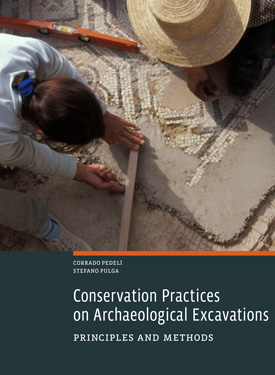
Conservation Practices on Archaeological Excavations: Principles and Methods
Corrado Pedelì and Stefano Pulga
2014
168 pages
PDF file size: 71.2 MB
Description
The relationship between archaeology and conservation has long been complex and, at times, challenging. Archaeologists are often seen as interested principally in excavation and research, while conservators are concerned mainly with stabilization and the prevention of deterioration. Yet it is often initial conservation in the field that determines the long-term survival and intelligibility of both moveable artifacts and fixed architectural features.
This user-friendly guide to conservation practices on archaeological excavations covers both structures and artifacts, starting from the moment when they are uncovered. Individual chapters discuss excavation and conservation, environmental and soil issues, deterioration, identification and condition assessment, detachment and removal, initial cleaning, coverings and shelters, packing, and documentation. There are also eight appendixes.
Geared primarily for professionals engaged in the physical practice of excavation, this book will also interest archaeologists, archaeological conservators, site managers, conservation scientists, museum curators, and students of archaeology and conservation.
Table of Contents
- Foreword to the English-Language Edition, Timothy P. Whalen
- Foreword, Nicholas Stanley Price
- Introduction
- Chapter 1. Excavation and Conservation
- Conservation during and after Excavation
- Factors That Characterize and Influence Archaeological Excavations
- Conservation Activities on an Excavation
- First Aid Operational Unit
- Chapter 2. Environmental Issues
- The Soil 13
- The Buried Object or Feature
- The Burial Environment
- Messa in luce: Principles and Conservation Issues
- Chapter 3. Properties and Deterioration of Archaeological Materials
- Overview
- Materials Common to Structures
- Inorganic Materials Common to Objects
- Organic Materials Common to Objects
- Chapter 4. Messa in luce: Exposing or Unearthing Objects and Structures
- Conservation Issues
- Principles of Exposure/Unearthing
- Conservation Techniques for Exposure/Unearthing
- Chapter 5. Identification and Assessment of Materials
- Parameters of Identification
- Immovable Features
- Movable Objects Composed of Inorganic Materials
- Movable Objects Composed of Organic Materials
- Chapter 6. Coverings and Shelters
- Overview
- Conventional Classification
- Typology and Implementation
- Chapter 7. Stabilization
- Structural Intervention
- Mechanical Interventions
- Chapter 8. Prevention of Biological Attack 71
- Direct Methods
- Indirect Methods
- Treatment Strategies
- Biocides
- Biochemical Methods
- Chapter 9. Consolidation
- Preliminary Considerations
- Methods of Consolidation
- Consolidation and Stabilization of Stratigraphy
- Chapter 10. Detachment and Removal
- Fixed Structures
- Movable Objects, Features, or Materials
- Chapter 11. Preliminary Cleaning of Movable Objects and Features
- Archaeological Practices and Conservation Issues
- Conservation Principles of Preliminary Cleaning
- Tools and Techniques
- Chapter 12. Preliminary Packing On-Site
- Conservation Packing
- Classification of Packing Products and Materials
- Properties of Packing Products and Materials
- Preliminary Packing Techniques
- Microclimate-Regulating Systems
- Chapter 13. Registration and Labeling
- Types of Information
- Recording Information/Data
- Labels
- Chapter 14. On-Site Temporary Storage
- General Characteristics
- Basic Requirements for Temporary Storage
- Examples of Temporary Storage Systems
- Chapter 15. Documentation
- Conservation Log/Report
- Conservation Activities and Treatments
- Type of Material Used
- Chapter 16. Long-Term Conservation of Site Features
- Reburial
- Conservation Measures for Site Presentation and Interpretation
- Protection of Masonry Walls (Capping and Repointing)
- Appendixes
- UNESCO Guidelines
- Classification of Materials
- Aggregates and Binders
- Consolidants
- Silica Gel
- Statistical Study of European Continental Climate
- Recovered Materials Form (finds, condition, etc.)
- Equipment and Materials List for a First Aid Operational Unit (FAOU)
- Acknowledgments
- Bibliography
- Index
- About the Authors
About the Authors
Corrado Pedelì is a senior conservator-restorer employed since 1985 at the Department of Cultural Heritage of Aosta Valley (northwestern Italy), where he is primarily responsible for conservation projects and scientific direction of conservation sites, monuments, and objects. He specializes in first aid and emergency conservation techniques on archaeological sites. Since 2004 he has been a consultant for ICCROM (International Centre for the Study of the Preservation and Restoration of Cultural Property), teaching several courses in the Middle East, Asia, southeastern Europe, and Italy.
Stefano Pulga is a conservator in private practice. He started as a conservator trainee at the Laboratory of Ottorino Nonfarmale in Bologna, Italy, then at CREPHART laboratory of Theo Antoine Hemanès in Geneva, Switzerland. Pulga has been involved in numerous conservation campaigns for archaeological heritage and monuments throughout Europe. Under the direction of the Department of Cultural Heritage of Aosta Valley, he has undertaken or coordinated the conservation work on various castles in the region (Fenis, Clay, Ussel, Morgex, Quart, Issogne, Graines) and Roman monuments in Aosta (the Pretorian gate and the city fortification walls).